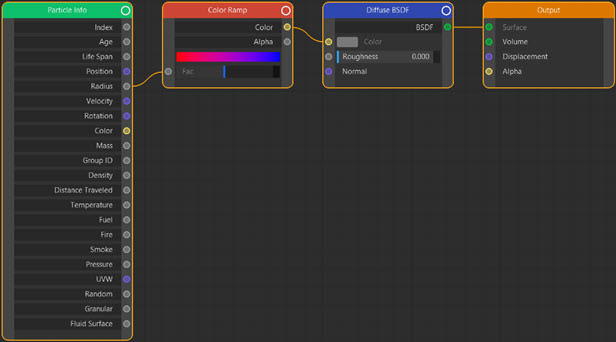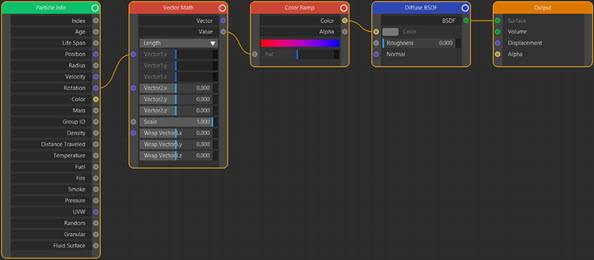Input: Particle Info
Important: when using this node please see the section 'Output value returned' below, and the page 'Rendering: Scene Units' for information about the values which are output by nodes when they return a parameter which is a size of something (e.g. particle radius).
Node Interface
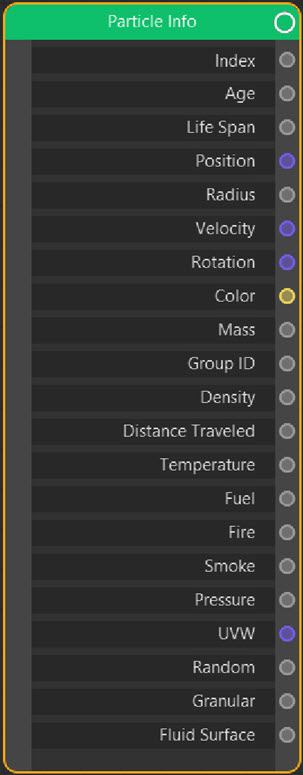
Example Output
In this scene the particles are coloured according to their size obtained from the Particle Info node:
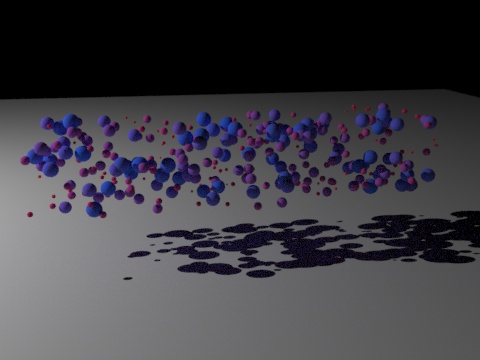
The node tree to do this looks like this:
(The Math node is necessary here because Cycles 4D works entirely in metres and the scene units in the scene are centimetres.)
Overview
| Function | Outputs information about particles generated by X-Particles |
| Nearest C4D equivalent | X-Particles Xpresso node |
This node is intended to return information about particles in the scene. Currently it works only with the X-Particles particle engine by Insydium.
Settings
None.
Output
Output value returned
You should be aware that Cycles 4D converts all size measurements into metres for internal use, and the result output by these ports, where they return a size value, will be in metres. For example, if you have a particle radius of 10 cm the actual value output will be 0.1 (10 cm = 0.1 m). This is important if you use the value to input into some other node.
 Note: for all these outputs, note that that raw data is returned. For example, the particle radius is returned as the actual radius, not as somewhere along a scale from 0 to 1. This is important if you use any of this data - as you certainly will - as input to a value on another node which requires a value in the range 0 to 1. An example of that would be the Fac input value on a Color Ramp node. If the particle radius is returned as, say, 3 units, this won't automatically be adjusted to somewhere in the range from 0 to 1. You will need to do this yourself using a Math node and based on the likely or known range of radius values you are likely to see.
Note: for all these outputs, note that that raw data is returned. For example, the particle radius is returned as the actual radius, not as somewhere along a scale from 0 to 1. This is important if you use any of this data - as you certainly will - as input to a value on another node which requires a value in the range 0 to 1. An example of that would be the Fac input value on a Color Ramp node. If the particle radius is returned as, say, 3 units, this won't automatically be adjusted to somewhere in the range from 0 to 1. You will need to do this yourself using a Math node and based on the likely or known range of radius values you are likely to see.
We have produced a range mapping node group which will do this for you if you input the expected maximum and minimum values. This is part of our node group pack and you can download it here.
Index
The particle's index. This is a unique ID value for each particle.
Age
The particle's age in seconds.
Life Span
The lifespan in seconds.
Position
A vector which is the particle's position in 3D space.
Radius
The particle's radius.
Velocity
The particle's velocity (a vector comprising both speed and direction).
Note that this is not the same as the particle's speed. Speed is a simple numeric value but Velocity is a vector. To get the speed you need to manipulate the vector to get its size. How to do this is explained in the How To: Get the Size of a Vector page.
Rotation
This is a measure of the rotation of a particle. It is a vector, so you have access to the axes on which the particle is rotating (the X, Y and Z components of the vector) and how fast it is rotating, which you can get from the length of the vector. In this scene, an X-Particles Spin modifier is used to increment the particle spin by 1 degree each frame, so they spin faster and faster. The spin speed is then piped into a Color Ramp node and as the speed increases the particles receive a different colour from the Color Ramp:
The node tree looks like this:
Color
The particle's colour.
Mass
The particle's mass.
Group ID
The number of the group the particle belongs to.
Density
The particle density, set when using the xpFluidSPH object.
Distance Travelled
The distance the particle has travelled.
Temperature
The particle's temperature.
Fuel
The particle's fuel value.
Fire
The particle's fire value.
Smoke
The particle's smoke value.
Pressure
This value is derived from the Fuel Pressure and Fire Pressure settings in the X-Particles Gaseous Modifier.
UVW
These are UV coordinates for fire and smoke texturing and which are only available when using an xpDomain object.
Random
A random value from 0 to 1.
Granular
 This output requires that an X-Particles Fluid FX object is in the scene; otherwise no useful data is returned.
This output requires that an X-Particles Fluid FX object is in the scene; otherwise no useful data is returned.
This is a value which is directly related to the number of neighbouring particles. Granularity levels are therefore lower nearer the edges of a fluid since the number of neighbours is lower.
Fluid Surface
 This output requires that an X-Particles Fluid FX object is in the scene; otherwise no useful data is returned.
This output requires that an X-Particles Fluid FX object is in the scene; otherwise no useful data is returned.
This value measures how close to the surface of a fluid a particle is. Note that this is not an actual distance setting. Higher values indicate that the particle is close to the surface.
Node tree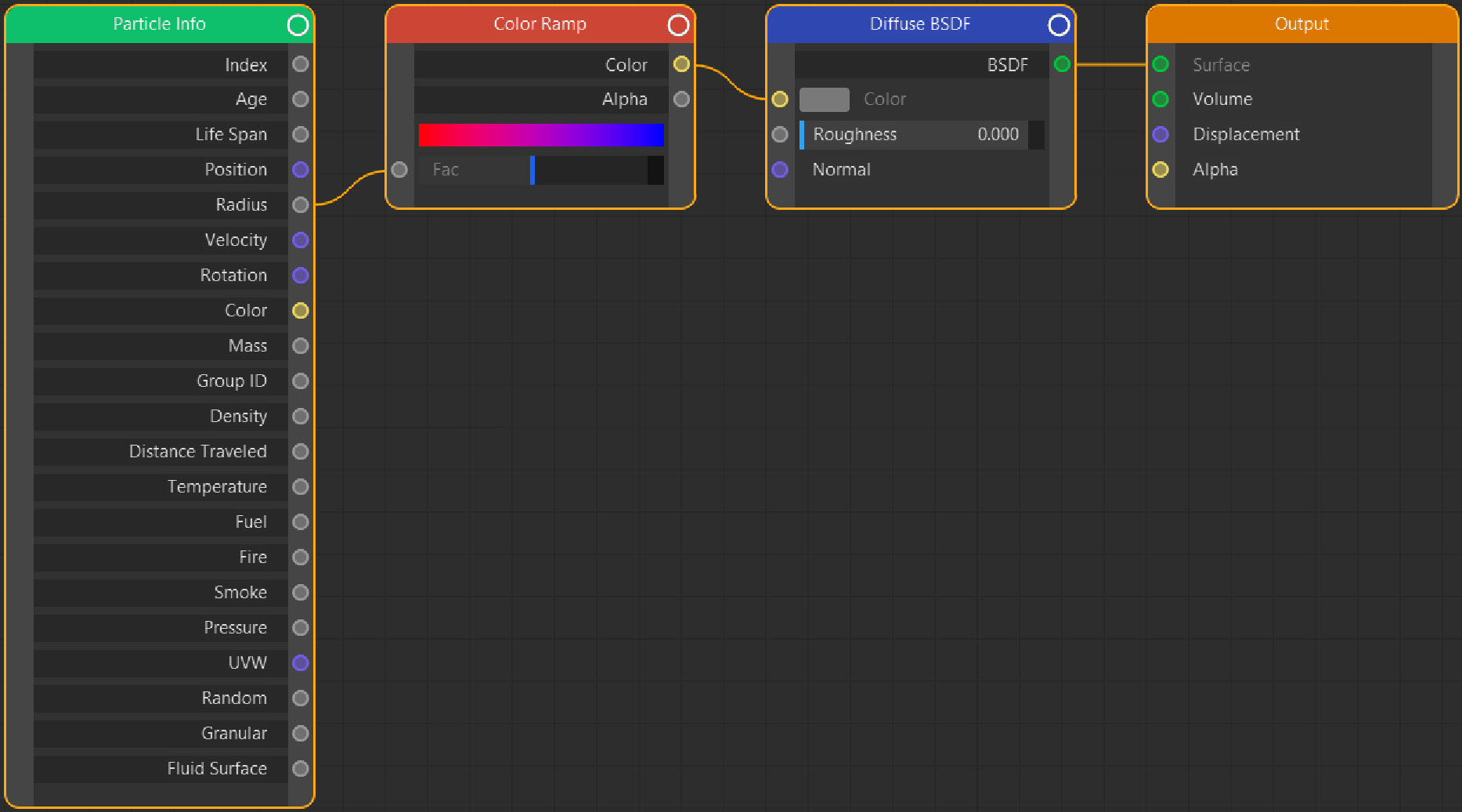
Node tree
